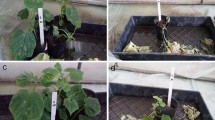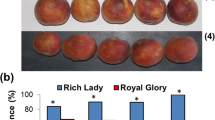Abstract
Pierce’s disease (PD) is a destructive bacterial disease of grapes caused by Xylella fastidiosa which is xylem-confined. The tolerance level to this disease varies among Vitis species. Our research was aimed at identifying unique xylem sap proteins present in PD-tolerant Vitis species. The results showed wide variation in the xylem sap protein composition, where a set of polypeptides with pI between 4.5 and 4.7 and M r of 31 kDa were present in abundant amount in muscadine (Vitis rotundifolia, PD-tolerant), in reduced levels in Florida hybrid bunch (Vitis spp., PD-tolerant) and absent in bunch grapes (Vitis vinifera, PD-susceptible). Liquid chromatography/mass spectrometry/mass spectrometry analysis of these proteins revealed their similarity to β-1, 3-glucanase, peroxidase, and a subunit of oxygen-evolving enhancer protein 1, which are known to play role in defense and oxygen generation. In addition, the amount of free amino acids and soluble sugars was found to be significantly lower in xylem sap of muscadine genotypes compared to V. vinifera genotypes, indicating that the higher nutritional value of bunch grape sap may be more suitable for Xylella growth. These data suggest that the presence of these unique proteins in xylem sap is vital for PD tolerance in muscadine and Florida hybrid bunch grapes.





Similar content being viewed by others
Abbreviations
- LC/MS/MS:
-
Liquid chromatography/mass spectrometry/mass spectrometry
- 2-D:
-
2-Dimensional electrophoresis
References
Olien, W. C., & Hegwood, C. P. (1990). HortScience, 25, 726–831.
Clayton, C. N. (1985). NC Agricultural Experiment Station Bulletin, 451, 37.
Gardner, M. W., & Hewitt, W. B. (1974). Bulletin, Department of Plant Pathology, University of California, Berkley and Davis. 225.
Gray, D. (2003). New plants for Florida: Grape. Circular 1440. In R. L. Jones, M. L. Duryea & B. J. Treat (Eds.), Florida agricultural experiment station. Gainesville: Institute of Food and Agricultural Sciences, University of Florida.
Hopkins, D. L., & Purcell, A. H. (2002). Plant Disease, 86, 1056–1066. doi:10.1094/PDIS.2002.86.10.1056.
Davis, M. J., Purcell, A. H., & Thompson, S. V. (1981). Current Microbiology, 5, 309–314. doi:10.1007/BF01566883.
Biles, C. L., & Abeles, F. B. (1991). Plant Physiology, 96, 597–601. doi:10.1104/pp.96.2.597.
Lopez-Millan, A. F., Morales, F., Abadia, A., & Abadia, J. (2000). Plant Physiology, 124, 878–884.
Andersen, P. C., Brodbeck, B. V., & Mizell, R. F., III. (1993). Physiologia Plantarum, 89, 783–790. doi:10.1111/j.1399-3054.1993.tb05285.x.
Andersen, P. C., Brodbeck, B. V., & Mizell, R. F., III. (1995). Journal of the American Society for Horticultural Science, 120, 36–42.
Rep, M., Dekker, H. L., Vossen, J. H., Boer, A. D., Houterman, P. M., Speijer, D., et al. (2002). Plant Physiology, 130, 904–917. doi:10.1104/pp.007427.
Rep, M., Dekker, H. L., Vossen, J. H., Boer, A. D., Houterman, P. M., Koster, C. G., et al. (2003). FEBS Letters, 534, 82–86. doi:10.1016/S0014-5793(02)03788-2.
Houterman, P. M., Speihjer, D., Dekker, H. L., De Koster, C. G., Cornelissen, B. J. C., & Rep, M. (2007). Molecular Plant Pathology, 8, 215–221. doi:10.1111/j.1364-3703.2007.00384.x.
van Loon, L. C., & van Strien, E. A. (1999). Physiological and Molecular Plant Pathology, 55, 85–97. doi:10.1006/pmpp.1999.0213.
Buhtz, A., Kolasa, A., Arlt, K., Walz, C., & Kehr, J. (2004). Planta, 219, 610–618. doi:10.1007/s00425-004-1259-9.
Ceccardi, T. L., Barthe, G. A., & Derrick, K. S. (1998). Plant Molecular Biology, 38, 775–783. doi:10.1023/A:1006039016393.
Chivasa, S., Ndimba, B. K., Simon, W. J., Lindsey, K., & Slabas, A. R. (2005). The Plant Cell, 17, 3019–3034. doi:10.1105/tpc.105.036806.
Vasanthaiah, H. K. N., Katam, R., & Basha, S. M. (2008). Applied Biochemistry and Biotechnology, . doi:10.1007/s12010-008-8380-3.
Yemm, E. W., & Cocking, E. C. (1955). Analyst (London), 80, 209–213. doi:10.1039/an9558000209.
Yemm, E. W., & Willis, A. J. (1954). The Biochemical Journal, 57, 508–514.
Sambrook, J., Fritsch, E. F., & Maniatis, T. (2000). Molecular cloning: A laboratory manual (2nd ed.). Cold Spring Harbor: Cold Spring Harbor Laboratory Press.
Purcell, A.H. (2003) http://www.cnr.berkeley.edu/xylella/control/central-valley-guidelines.html.
Basha, S. M. (1979). Plant Physiology, 63, 301–306. doi:10.1104/pp.63.2.301.
Basha, S. M., & Roberts, R. M. (1981). Plant Physiology, 67(5), 936–939. doi:10.1104/pp.67.5.936.
Shen, S., Yuxiang, J., & Kuang, T. (2003). Proteomics, 3, 527–535. doi:10.1002/pmic.200390066.
Kehr, J., Buhtz, A., & Giavalisco, P. (2005). BMC Plant Biology, 5, 11. doi:10.1186/1471-2229-5-11.
Trudel, J., Grenier, J., Potvin, C., & Asselin, A. (1998). Plant Physiology, 118, 1431–1438. doi:10.1104/pp.118.4.1431.
Chinnasamy, G. (2005). In Z. A. Siddiqui (Ed.), PGPR: Biocontrol and Biofertilization, pp. 233–255. Netherlands: Springer.
Welinder, K. G. (1992). Current Opinion in Structural Biology, 2, 388–393. doi:10.1016/0959-440X(92)90230-5.
Young, S. A., Guo, A., Guikema, J. A., White, F. F., & Leach, J. E. (1995). Plant Physiology, 107(4), 1333–1341. doi:10.1104/pp.107.4.1333.
Durrant, W. E., & Dong, X. (2004). Annual Review of Phytopathology, 42, 185–209. doi:10.1146/annurev.phyto.42.040803.140421.
Harman, G. E., Howell, C. R., Vitebro, A., Chet, I., & Lorito, M. (2004). Nature Reviews Microbiology, 2, 43–56. doi:10.1038/nrmicro797.
Tamura, N., Inoue, Y., & Chenaie, G. M. (1985). BBA-Bioenergetics, 976(2–3), 173–181. doi:10.1016/S0005-2728(89)80227-0.
Bhattacharyya, A., Stilwagen, S., Reznik, G., Feil, H., Eil, S. W., & Anderson, I. (2002). Genetical Research, 12, 1556–1563. doi:10.1101/gr.370702.
Dalk, K. (2002) Genome News Network. http://www.genomenewsnetwork.org/articles/09_02/xylella.shtml.
Leite, B., Andersen, P. C., & Ishida, M. L. (2004). FEMS Microbiology Letters, 230, 283–290. doi:10.1016/S0378-1097(03)00917-0.
Acknowledgments
This project was funded by a grant from USDA, FLAX 2002-02969 and FLAX 00-005. We also acknowledge Dr. Scott McClung, Protein Core laboratory, University of Florida, for the LC/MS/MS analysis.
Author information
Authors and Affiliations
Corresponding author
Rights and permissions
About this article
Cite this article
Basha, S.M., Mazhar, H. & Vasanthaiah, H.K.N. Proteomics Approach to Identify Unique Xylem Sap Proteins in Pierce’s Disease-Tolerant Vitis Species. Appl Biochem Biotechnol 160, 932–944 (2010). https://doi.org/10.1007/s12010-009-8620-1
Received:
Accepted:
Published:
Issue Date:
DOI: https://doi.org/10.1007/s12010-009-8620-1




